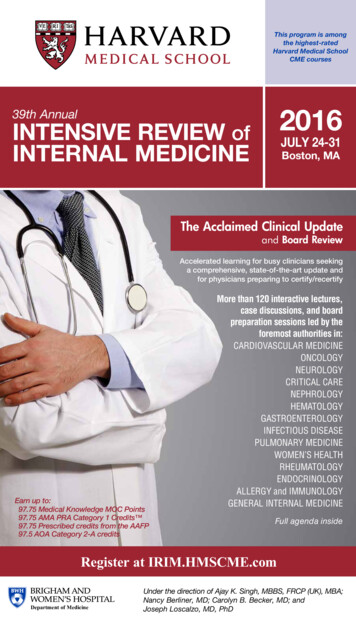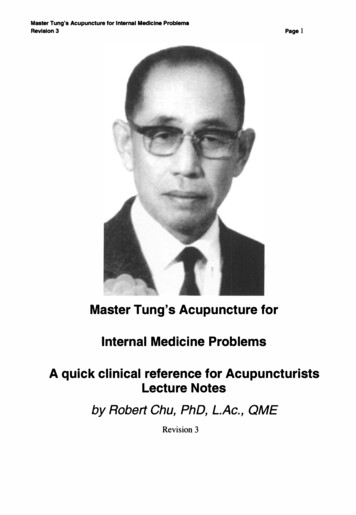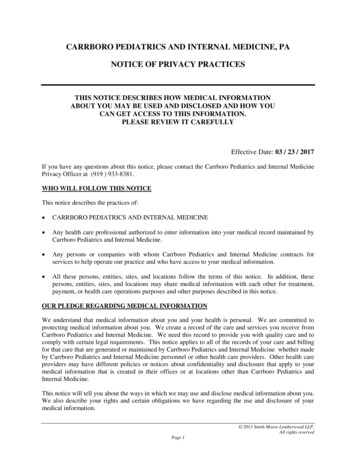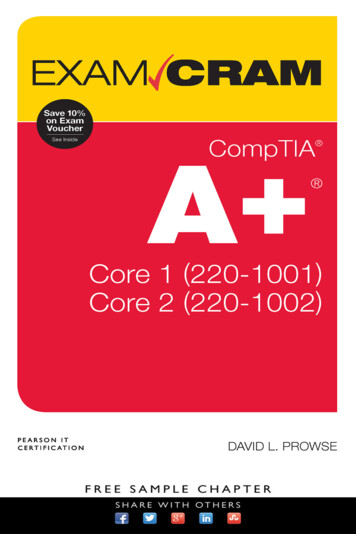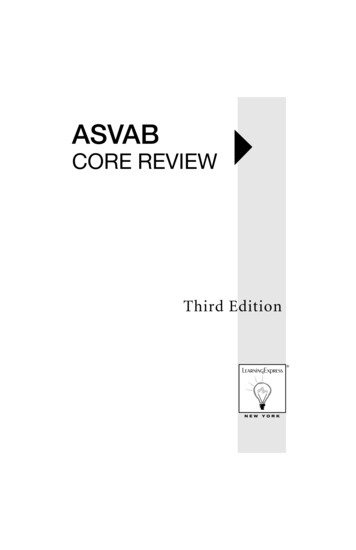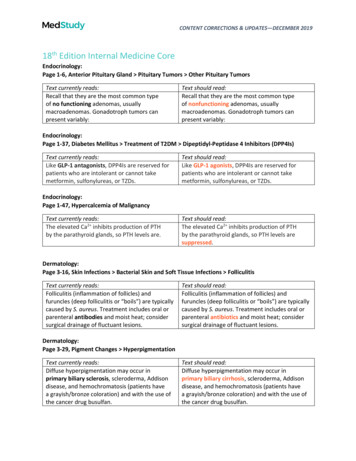
Transcription
CONTENT CORRECTIONS & UPDATES—DECEMBER 201918th Edition Internal Medicine CoreEndocrinology:Page 1-6, Anterior Pituitary Gland Pituitary Tumors Other Pituitary TumorsText currently reads:Recall that they are the most common typeof no functioning adenomas, usuallymacroadenomas. Gonadotroph tumors canpresent variably:Text should read:Recall that they are the most common typeof nonfunctioning adenomas, usuallymacroadenomas. Gonadotroph tumors canpresent variably:Endocrinology:Page 1-37, Diabetes Mellitus Treatment of T2DM Dipeptidyl-Peptidase 4 Inhibitors (DPP4Is)Text currently reads:Like GLP-1 antagonists, DPP4Is are reserved forpatients who are intolerant or cannot takemetformin, sulfonylureas, or TZDs.Text should read:Like GLP-1 agonists, DPP4Is are reserved forpatients who are intolerant or cannot takemetformin, sulfonylureas, or TZDs.Endocrinology:Page 1-47, Hypercalcemia of MalignancyText currently reads:The elevated Ca2 inhibits production of PTHby the parathyroid glands, so PTH levels are.Text should read:The elevated Ca2 inhibits production of PTHby the parathyroid glands, so PTH levels aresuppressed.Dermatology:Page 3-16, Skin Infections Bacterial Skin and Soft Tissue Infections FolliculitisText currently reads:Folliculitis (inflammation of follicles) andfuruncles (deep folliculitis or “boils”) are typicallycaused by S. aureus. Treatment includes oral orparenteral antibodies and moist heat; considersurgical drainage of fluctuant lesions.Text should read:Folliculitis (inflammation of follicles) andfuruncles (deep folliculitis or “boils”) are typicallycaused by S. aureus. Treatment includes oral orparenteral antibiotics and moist heat; considersurgical drainage of fluctuant lesions.Dermatology:Page 3-29, Pigment Changes HyperpigmentationText currently reads:Diffuse hyperpigmentation may occur inprimary biliary sclerosis, scleroderma, Addisondisease, and hemochromatosis (patients havea grayish/bronze coloration) and with the use ofthe cancer drug busulfan.Text should read:Diffuse hyperpigmentation may occur inprimary biliary cirrhosis, scleroderma, Addisondisease, and hemochromatosis (patients havea grayish/bronze coloration) and with the use ofthe cancer drug busulfan.
CONTENT CORRECTIONS & UPDATES—DECEMBER 2019Infectious Disease:Page 4-12, Gastrointestinal Infections Diarrhea Due To Chlostridium Difficile TreatmentText currently reads:Treat nonsevere disease (WBC count 15,000 cells/ μL [15 109/L] or a serumcreatine 1.5 mg/dL [132.6 μmol/L]) withPO vancomycin (VANC) or PO fidaxomicin (FDX).Text should read:Treat nonsevere disease (WBC count 15,000 cells/ μL [15 109/L] and a serumcreatine 1.5 mg/dL [132.6 μmol/L]) withPO vancomycin (VANC) or PO fidaxomicin (FDX).Infectious Disease:Page 4-13, Liver and Biliary Infections PeritonitisText currently reads:It is critical to differentiate SBP from secondarybacterial peritonitis because: mortality is 80% for patients with SBP whoundergo an exploratory laparotomy, and mortality is 100% for patients with SBP whodo not go to surgery!Text should read:It is critical to differentiate SBP from secondarybacterial peritonitis because: mortality is 80% for patients with SBP whoundergo an exploratory laparotomy, and mortality is 100% for patients with secondarybacterial peritonitis who do not go to surgery!Infectious Disease:Page 4-63, Viruses Varicella-Zoster Virus Herpes Zoster (Shingles) Vaccination for Herpes ZosterText currently reads:The most recent zoster vaccine, called Shingrix,was approved by the FDA in October 2017.In those 50–69 years of age, Shingrix has aneffectiveness of 97% and 91% in preventingherpes zoster and PNH, respectively.Text should read:The most recent zoster vaccine, calledrecombinant zoster vaccine (RZV; Shingrix),was approved by the FDA in October 2017.In those 50–69 years of age, recombinant zostervaccine (RZV; Shingrix) has an effectiveness of97% and 91% in preventing herpes zoster andPNH, respectively.Infectious Disease:Page 4-71, Bacterial Agents Beta-Lactam Antibiotics Cephalosporins 3rd Generation CephalosporinsText currently reads:Cefpodoxime is the only oral 3rd generationcephalosporin.Text should read:Cefdinir (Omnicef), cefditoren (Spectracef),cefixime (Suprax), cefpodoxime-proxetil(Vantin), and ceftibuten (Cedax) are3rd generation cephalosporins.
CONTENT CORRECTIONS & UPDATES—DECEMBER 2019Pulmonary Medicine:Page 6-8, Respiratory Physiology HypoxemiaText currently reads:5) High altitude (low FiO2) results in a reducedPAO2. The A-a gradient is normal unless lungdisease is present.Text should read:5) High altitude decreases atmospheric pressureand results in a reduced PAO2. The A-a gradient isnormal unless lung disease is present.Page 6-3, Pulmonary Hypertension Pulmonary Function Tests Lung Volumes, Table 6-2Text currently oracicObstructive Table 6-2: Typical PFTsTLCFEV1FEV1/FVC or ( 80%)Nlnormal or ( 80%)NlnormalNl to ( 70%)RVDLCO Nl Nl to RVDLCO Nl Nl to Text should racicObstructive Table 6-2: Typical PFTsTLCFEV1FEV1/FVC or ( 80%)Nlnormal or ( 80%)NlnormalNl to ( 70%)Page 6-46, Pulmonary Hypertension Treatment of PH Exercise, Anticoagulants, Diuretics, andOxygenText currently reads:Give anticoagulants for Group 1 onIV prostaglandins, according to the ACCF/AHA2009 Expert Consensus Document on PulmonaryHypertension.Text should read:Give anticoagulants for Group 4 PH, according tothe ACCF/AHA 2009 Expert Consensus Documenton Pulmonary Hypertension.
CONTENT CORRECTIONS & UPDATES—DECEMBER 2019Nephrology & Urology:Page 7-57, Potassium Disorders Hyperaldosteronism Bartter and Gitelman SyndromesText currently reads:Characteristics of Bartter’s and Gitelman’s aresummarized in Table 7-12. The easiest way todistinguish Bartter’s from Gitelman’s: patientswith Bartter’s have hypercalciuria,and patients with have hypocalciuria.Text should read:Characteristics of Bartter’s and Gitelman’s aresummarized in Table 7-12. The easiest way todistinguish Bartter’s from Gitelman’s: patientswith Bartter’s have hypercalciuria,and patients with Gitelman’s have hypocalciuria.Hematology:Page 8-5, Anemia Working Up Anemia The Anemia Workup Figure 8-9Text currently reads:Low iron and ferritin with low TIBCText should read:Low iron and high–normal ferritin with low TIBCOncology:Page 9-28, Cancer Therapies Use of Growth FactorsText currently reads:Erythropoietin is indicated for the treatmentof the following: Chemotherapy-induced anemiawith Hb 10 g/dL.Remember that there is a risk of thrombosis,especially if hemoglobin is 12 g/dL. Anemia of chronic kidney diseasewith Hb 10 g/dL. Anemia in HIV patients taking zidovudine (AZT)Text should read:Erythropoietin is indicated for the treatmentof the following: Chemotherapy-induced anemiawith Hb 10 g/dL.Remember that there is a risk of thrombosis,especially if hemoglobin is 12 g/dL. Anemia of chronic kidney diseasewith Hb 10 g/dL. Anemia in HIV patients taking zidovudine (ZDV)
CONTENT CORRECTIONS & UPDATES—DECEMBER 2019Rheumatology:Page 10-21, Systemic Lupus Erythematosus Drug-Induced LupusText currently reads:Drugs with the highest risk for drug-inducedlupus (DIL) are procainamide, hydralazine, andpenicillamine. Other drugs that have been linkedwith DIL are chlorpromazine, propylthiouracil,hydralazine, isoniazid, phenytoin, TNF inhibitors,minocycline, selective serotonin reuptakeinhibitors, proton pump inhibitors, and thiazidediuretics.Text should read:Drugs with the highest risk for drug-inducedlupus (DIL) are procainamide, hydralazine, andpenicillamine. Other drugs that have been linkedwith DIL are chlorpromazine, propylthiouracil,isoniazid, phenytoin, TNF inhibitors, minocycline,selective serotonin reuptake inhibitors, protonpump inhibitors, and thiazide diuretics.Rheumatology:Page 10-38, Less Common Arthropathies Adult-Onset Still DiseaseText currently reads:AOSD presents with a distinctive evanescent(6fleeting or vanishing), macular, salmon-pinkrash that coincides with a daily (quotidian)high-spiking fever and significant leukocytosis(Yamaguchi criteria).Text should read:AOSD presents with a distinctive evanescent(fleeting or vanishing), macular, salmon-pinkrash that coincides with a daily (quotidian)high-spiking fever and significant leukocytosis(Yamaguchi criteria).Rheumatology:Page 10-62, Office Orthopedics Monoarticular Joint Disorders Wrist De Quervain TenosynovitisText currently shows this figure:Text should show this figure:
CONTENT CORRECTIONS & UPDATES—DECEMBER 2019Rheumatology:Page 10-62, Office Orthopedics Monoarticular Joint Disorders Wrist De Quervain TenosynovitisText currently reads:Although there are several bedside tests usedfor diagnosis, the hallmark test is known asthe Finkelstein test (forced ulnar motion of thewrist with the thumb adducted and clasped bythe patient’s other fingers), which reproducesthe pain.Text should read:Although there are several bedside tests usedfor diagnosis, the hallmark test has come to becalled the Finkelstein test (forced ulnar motionof the wrist with the thumb adducted andclasped by the patient’s other fingers), whichreproduces the pain.Women’s and Men’s Health:Page 11-6, Obstetrics Cardiology Disorders in Pregnancy Cardiac IssuesText currently reads:Hypertensive cardiomyopathy (HCM) amongasymptomatic women is not a contraindicationfor pregnancy.Text should read:Hypertrophic cardiomyopathy (HCM) amongasymptomatic women is not a contraindicationfor pregnancy.Women’s and Men’s Health:Page 11-10, Obstetrics Endocrinology Disorders in Pregnancy Thyroid Disease HyperthyroidismText currently reads:This is normal physiology of pregnancy in whichhuman chorionic gonadotropin (hCG) stimulatesthyroid stimulating hormone () receptors,resulting in a mild elevation in T3/T4 andsuppression of TSH.Text should read:This is normal physiology of pregnancy in whichhuman chorionic gonadotropin (hCG) stimulatesthyroid-stimulating hormone (TSH) receptors,resulting in a mild elevation in T3/T4 andsuppression of TSH.Women’s and Men’s Health:Page 11-24, Erectile Disfunction Treatment OptionsText currently reads:Relative contraindications are heart failure,hypotension, unstable angina, hypertensivecardiomyopathy (HCM), and severe aorticstenosis.Text should read:Relative contraindications are heart failure,hypotension, unstable angina, hypertrophiccardiomyopathy (HCM), and severe aorticstenosis.
CONTENT CORRECTIONS & UPDATES—DECEMBER 2019Neurology: Page 12-8, Seizures Seizure Management Chronic Treatment of Seizures Table 12-2 “Notable Advantages and Disadvantages of Antiepileptic Drugs”Text currently reads:LamotrigineFocal (adjunctive use)GeneralizedText should read:Good: wide spectrum,good efficacy, welltolerated in elderlypatientsBad: can cause severe rashand SJS with rapidtitration; reduces efficacyof OCPsLamotrigineFocal (adjunctive use)GeneralizedGood: wide spectrum,good efficacy, welltolerated in elderlypatientsBad: can cause severe rashand SJS with rapidtitration; OCPs decreaseserum concentrationof lamotrigineCardiology:Page 13-1, Physical Exam PulsesText currently reads:While deflating the cuff very slowly, note thesystolic blood pressure where the 1st Korotkoffsound is heard only during inspiration.Text should read:While deflating the cuff very slowly, note thesystolic blood pressure where the 1st Korotkoffsound is heard only during expiration.Cardiology:Page 13-11, Cardiac MedicationsText currently reads: A negative inotrope is a medication thatdecreases cardiac contractility. A negative chromotrope is a medication thatslows heart rate.Text should read: A negative inotrope is a medication thatdecreases cardiac contractility. A negative chronotrope is a medication thatslows heart rate.
CONTENT CORRECTIONS & UPDATES—DECEMBER 2019Cardiology:Page 13-65, Pericardial Diseases Constrictive Pericarditis, Table 13-13Text currently reads:Table 13-13: Distinguishing Tamponade and Constrictive PericarditisFindingsTamponadeConstrictive PericarditisDuration of symptomsHours to daysMonths to yearsChest pain, friction rubOften presentAbsentPulsus paradoxusPresentUsually absentKussmaul signAbsentUsually absentDiastolic knockAbsentOften presentPericardial calcificationAbsentOften presentThickened pericardiumAbsentPresenton CT/MRIPericardial effusionPresentAbsentJugular venous waveformsProminent x descentProminent x and y descentsDiastolic pressuresEqualEqualEcho findingsPericardial effusion, collapse of Marked respiratory variation inRV/RAtransmitral flowSystemic diseaseCancer, uremia, recentTB, previous XRT, remotecardiothoracic surgery, chestcardiothoracic surgerytraumaText should read:Table 13-13: Distinguishing Tamponade and Constrictive PericarditisFindingsTamponadeConstrictive PericarditisDuration of symptomsHours to daysMonths to yearsChest pain, friction rubAbsentOften presentPulsus paradoxusPresentUsually absentKussmaul signAbsentUsually absentDiastolic knockAbsentOften presentPericardial calcificationAbsentOften presentThickened pericardiumAbsentPresenton CT/MRIPericardial effusionPresentAbsentJugular venous waveformsProminent x descentProminent x and y descentsDiastolic pressuresEqualEqualEcho findingsPericardial effusion, collapse of Marked respiratory variation inRV/RAtransmitral flowSystemic diseaseCancer, uremia, recentTB, previous XRT, remotecardiothoracic surgery, chestcardiothoracic surgerytrauma
CONTENT CORRECTIONS & UPDATES—DECEMBER 2019Cardiology:Page 13-90, The Electrocardiogram Analysis Summary Findings from ECG Case StudiesText currently reads:Case 2: Note the sinus rhythm with MobitzType 2 second-degree 2:1 AV block. This initiallylooks like Mobitz 2, but there is a subtle increasein the PR interval, and this also has a narrow QRScomplex (Mobitz 2 usually has a wide complex).Text should read:Case 2: Note the sinus rhythm with MobitzType 1 second-degree 2:1 AV block. This initiallylooks like Mobitz 2, but there is a subtle increasein the PR interval, and this also has a narrow QRScomplex (Mobitz 2 usually has a wide complex).Gastroenterology:Page 14-11, Stomach DyspepsiaText currently reads:Dyspepsia is most often functional or caused bymedications (e.g., iron, ASA, NSAIDs), but ifonset is recent, there is no potentially causativemedication, and the patient is 40–50 yearsof age, consider an organic cause; i.e., consideran EGD.Text should read:Dyspepsia is most often functional or caused bymedications (e.g., iron, ASA, NSAIDs), but if onsetis recent, there is no potentially causativemedication, and the patient is 60 years of age,consider an organic cause; i.e., consider an EGD.Psychiatry:Page 16-35, Complications of Drug Therapy Neuroleptic Malignant Syndrome ManagementText currently reads:Use of bromocriptine (muscle relaxant) anddantrolene (dopamine agonist) have beencontroversial, but they can be used if clinicallyindicated.Text should read:Use of bromocriptine (dopamine agonist) anddantrolene (muscle relaxant) have beencontroversial, but they can be used if clinicallyindicated.General Internal Medicine:Page 15-6, Biostatistics Diagnostic Testing and Screening Sensitivity and SpecificityText currently reads:A test with 50% sensitivity and 100% specificitymeans that the test will only identify half ofthe patients with the disease—but you can be100% confident that a negative result meansthe patient truly does not have the disease(i.e., no results are falsely positive).Text should read:A test with 50% sensitivity and 100% specificitymeans that the test will only identify half ofthe patients with the disease—but you can be100% confident that a positive result meansthe patient truly has the disease (i.e., no resultsare falsely positive).
CONTENT CORRECTIONS & UPDATES—DECEMBER 2019 18th Edition Internal Medicine Core Endocrinology: Page 1-6, Anterior Pituitary Gland
